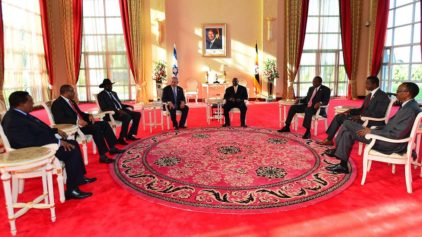A consortium of 19 Eastern and Southern African countries are considering establishing a common currency to expand the economic cohesion and growth of the region.
The members of the Common Market for Eastern and Southern Africa include Egypt, Ethiopia, Kenya, Libya, Rwanda, Sudan, South Sudan, Uganda and Zimbabwe. A new report by the African Development Bank outlines the benefits of a new currency.
Donald Kaberuka, the president of the African Development Bank, says the monetary union would create greater economic integration in the region.
“Fiscal convergence is essential to COMESA’s macroeconomic convergence program, and is a bridge between monetary and trade integration programs,” Kaberuka said.
The currency union also has the backing of the International Monetary Fund, which says it will provide as much support as is needed. Finance ministers from five of the states traveled to Washington, D.C. recently for a brainstorming session at the IMF, where officials there encouraged the move and said it would lend its wealth of expertise from helping to establish common currencies in West Africa and the European Union. But an IMF source told The East African website that it would not force the issue.
According to the source, the areas where the IMF could provide support include figuring out the degree to which member states’ exchange rates and monetary policies are similar, stability of financial institutions in the wake of cross-border movement of services, and the collection and distribution of revenues.
There has been a common currency in West Africa, the West African CFA franc, since 1945, when all the French colonies began using the same currency. They continued to use the franc even after they gained their independence. The West African CFA franc is currently used by eight countries: Benin, Burkina Faso, Côte d’Ivoire, Guinea-Bissau, Mali, Niger, Sénégal and Togo.
In addition, six countries use the Central African CFA franc: Cameroon, Central African Republic, Chad, Republic of the Congo, Equatorial Guinea and Gabon. All former French colonies, they also began using the common currency in 1945.
South Africa has its own currency, the South Africa rand, which is also shared by Swaziland and Lesotho.
But a major outstanding question is the timetable that would be used to put each of the 19 East and Southern African nations on a path to resolving the many issues that stand in the way, including corruption, level of debt, and inflation. Many of the member states, such as Egypt, Libya, Sudan and South Sudan are in the midst of significant political and economic upheavals that make it difficult for them to concentrate on such a complex issue as a common currency.
Some experts said it might be at least a decade or more before they could resolve all the inherent issues.
Prof. Manasseh Nshuti, a Kigali, Rwanda-based economist, said the initiative is important, but the time is not right to pursue it. He said the member countries first need to concentrate on establishing their own financial independence.
“We need to have harmonized fiscal regimes and we still have other outstanding issues like corruption, lack of transparency and different inflation rates, meaning that it might be difficult for the member countries to sort these issues,” said Nshuti, a former finance minister.
He pointed out that East Africa was supposed to be first establishing its own common currency, but that doesn’t appear any closer to fruition.
“We are not yet ready for the COMESA currency. We haven’t even achieved the EAC Monetary Union that we have always been singing about,” he said.
The EAC single currency had initially been proposed for 2012, but the signing of the agreement to push the five East African nations — which include Kenya, Rwanda, Uganda, Burundi and Tanzania — in the direction of a common currency has been postponed until November 2013.
After the protocol is signed, Dr. Adam Mugume, the director of research at the Bank of Uganda, estimates that it would take at least 10 years to scale the many obstacles before a single currency can be used.


